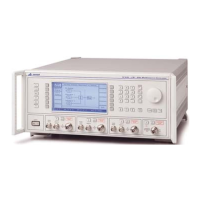INSTALLATION
46882/439 2-9
Rack mounting
The instrument, which is normally supplied for bench mounting, may be mounted in a standard
19 inch rack (see Chapter 1, ‘Versions, options and accessories’). There are two slide rack
mounting kits to accommodate different depths of cabinet. These kits include full fitting
instructions. A rack mounting kit without slides is also available which contains front-panel
mounting brackets only.
Routine safety testing and inspection
In the UK the ‘Electricity at Work Regulations’ (1989) section 4(2) places a requirement on the
users of equipment to maintain it in a safe condition. The explanatory notes call for regular
inspections and tests together with a need to keep records.
The following electrical tests and inspection information is provided for guidance purposes and
involves the use of voltages and currents that can cause injury. It is important that these tests are
only performed by competent personnel.
Prior to carrying out any inspection and tests the equipment must be disconnected from the mains
supply and all external signal connections removed. All tests should include the equipment’s own
supply lead, all covers must be fitted and the supply switch must be in the ‘ON’ position.
The recommended inspection and tests fall into three categories and should be carried out in the
following sequence:
1. Visual inspection
2. Earth bonding test
3. Insulation resistance test.
1. Visual inspection
A visual inspection should be carried out on a periodic basis. This interval is dependent on the
operating environment, maintenance and use, and should be assessed in accordance with
guidelines issued by the Health and Safety Executive (HSE). As a guide, this equipment, when
used indoors in a relatively clean environment, would be classified as ‘low risk’ equipment and
hence should be subject to safety inspections on an annual basis. If the use of the equipment is
contrary to the conditions specified, you should review the safety re-test interval.
As a guide, the visual inspection should include the following where appropriate:
Check that the equipment has been installed in accordance with the instructions provided (e.g. that
ventilation is adequate, supply isolators are accessible, supply wiring is adequate and properly
routed).
• The condition of the mains supply lead and supply connector(s).
• The correct rating and type of supply fuses.
• Security and condition of covers and handles.
• Check the presence and condition of all warning labels and markings and supplied safety
information.
• Check the wiring in re-wireable plugs and appliance connectors.
• Check the cleanliness and condition of any ventilation fan filters.
• Check that the mains supply switch isolates the equipment from the supply.
• Check the supply indicator functions (if fitted).
If any defect is noted this should be rectified before proceeding with the following electrical tests.
2. Earth bonding tests
Earth bonding tests should be carried out using a 25 A (12 V maximum open circuit voltage) DC
source. Tests should be limited to a maximum duration of 5 seconds and have a pass limit of
0.1 Ω after allowing for the resistance of the supply lead. Exceeding the test duration can cause
damage to the equipment. The tests should be carried out between the supply earth and exposed

